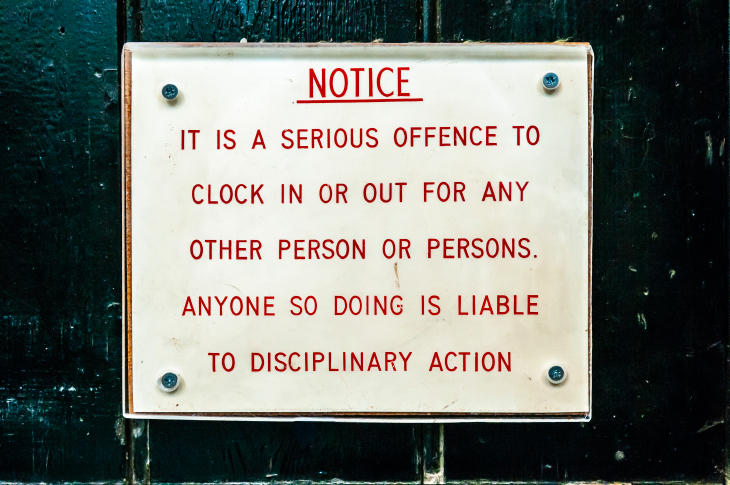Watching the Clock - Technology to Monitor Staff Time
Retail employees are mostly honest and hard-working individuals that are motivated to give a great experience to customers. The majority wouldn’t consider stealing from their employer in any way. Yet, when it comes to time and attendance, lack of controls gives employees the perfect opportunity to take advantage.
Trust, At What Price?
Let’s put this challenge into some perspective. Payroll is retailers’ biggest operating cost by far. The biggest retailers have over 2 million employees, and every minute counts. Yet, the American Society of Employers estimates that 20 percent of every dollar earned by a company is lost to employee time theft. This could be from incorrect recording of times, personal activities, buddy punching or frequent breaks — and it is an enormous problem.
The current approach to managing employee time and attendance falls into a few categories:
- Retailers that do not monitor their staff attendance at all
- Retailers that monitor their staff attendance manually, i.e., supervisor or manager noting lateness and absence
- Retailers that use technology to monitor their staff attendance
The majority of retailers fall into the second category of manually monitoring staff attendance.
Those that don’t monitor their staff at all essentially trust that people will do the right thing. They assume if staff is late, for example, they’ll make up the time at some point. This might well be true, and arguably a trusting environment is more likely to breed a feeling of responsibility. However, it’s a significant risk when you consider the costs.

What’s the Best Way of Managing Time and Attendance?
Those who adopt a technological approach to managing time and attendance are usually the most successful. Technology doesn’t require difficult conversations — it just relays the facts. If you were supposed to work 8:00 AM - 5:00 PM. and you clock in at 8:05 and clock out at 5:00, you’re 5 minutes short of your hours. Simple!
It is vitally important that the type of technology used is robust, accurate and frictionless. Doing so will dramatically reduce any challenges of adopting the new technology and ensure that it becomes second nature to the employees.
One example of technology being manipulated is a retailer that introduced a kind of old-school punch-in system, where employees used RFID cards to swipe in and out of the building. At face value this looked like a sensible solution. However, the cards could be scanned by anyone, so “buddy punching” was commonplace. This caused a bigger problem than their previous method of managers monitoring attendance, as the managers stopped monitoring all together due to the new system being in place.
Technology can help make decisions based on rules rather than biases. Of course, the human touch is always needed when dealing with people, especially in extenuating circumstances, but technology can make the monitoring significantly more robust.
So, how can retailers ensure that technology adoption is seamless, robust and consistent? They need an identification method that can’t be fooled and leaves no ambiguity.
Using Biometrics to Manage and Build Control
Biometric technology has the answer. An employee using either their fingerprint or their face makes it impossible to trick — and is also fast and frictionless. Not only that, biometric technology also offers multiple advantages and efficiencies when combined with actions including:
- Logging on to a corporate computer
- Management approval on the cash register
- Unlocking secure areas such as cash offices or security cages
- Self-checkout authorizations (rather than using pin codes or barcodes)
- Accepting deliveries
In terms of the user process, it’s very simple — the employee registers their fingerprint or face and they’re in the system. This is a standard way to identify yourself these days, with mobile devices using this technology as common practice. One of the biggest benefits to the employees is the speed and convenience in the process. With the data tokenized as well, employers can rest easy in terms of GDPR and other regulatory mandates.
As far as convenience, it gives employees one less process to follow, improving efficiency and giving them more time with customers.
For the business, it gives back control and is secure, robust and efficient. With turnover being a major factor for retailers (running as high as 60%), as soon as an employee leaves, they can be removed from the system quickly and easily, preventing any risk of abuse.
In summary, using biometrics to track employee time and attendance ensures everyone is treated equally and makes life easier for everyone!
Want to know more about using biometrics for retail loss prevention?
Read our previous blogs on Stop Store Theft By Locking Everything Up...Or Read This.
Or download the white paper: How Forward-thinking Retailers are Using Biometrics to Solve Their Biggest Problems >>
Steve Hewitt is the founder of Profitunity, which exists to drive the profitability of retailers through partnership with solution providers. Previously he worked as Consultant Head of Loss Prevention for Waitrose, Head of Loss Prevention at Morrisons and Head of Loss Prevention at Marks and Spencer. He is a member of the ECR Europe Shrink and On Shelf Availability team. Steve applies insights gained from 26-years in retailing as he consults with organizations to usher them into a complete mindset change, resulting in significant growth in profit. He has also delivered business cases around industry leading RFID initiatives and new ways of engaging people in the ‘art of the possible’ on total loss. Steve's experience in the wider retail arena enables him to have a holistic view on loss and the levers to pull to drive profit in retailers.
